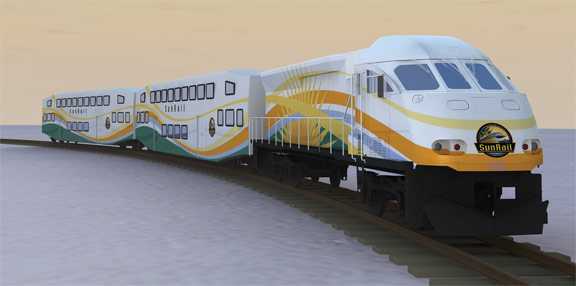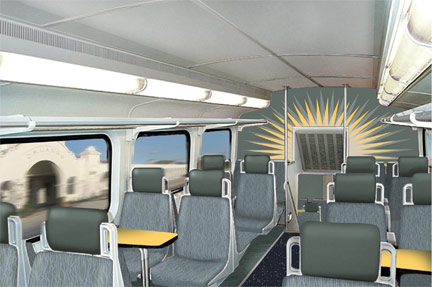
NEW TRACK CITY
 Light rail was a long time coming to Central Florida. But when the first phase of SunRail comes on line by the spring of 2014, transportation in the region will enter a new era.
Light rail was a long time coming to Central Florida. But when the first phase of SunRail comes on line by the spring of 2014, transportation in the region will enter a new era.
When it’s fully built out in 2016, the north-south commuter line will run 61.5 miles from DeLand in Volusia County to Poinciana in Osceola County. Phase One is 32 miles long with 12 stations and will originate in DeBary in Volusia County and terminate at Sand Lake Road in Orange County.
Phase Two will add five more stations and 29.5 miles of track. And the Florida Department of Transportation (FDOT) is working with the communities surrounding each station to help facilitate transit-oriented development (TOD). “Depending upon location—rural, suburban, inner city—TOD typically includes a pedestrian friendly mix of residential, commercial, professional and retail space to support transit,” says Steve Olson, public information manager for the Florida Department of Transportation for District Five/East-Central Florida Region.
SunRail will provide many benefits to the region, say boosters, not the least of which is providing a transportation alternative to the region’s congested road network. That means significantly shorter commutes and a way to avoid I-4, which is slated for extensive work shortly after SunRail debuts.
“Business will also benefit,” says Britt Beemer, chairman and CEO of America’s Research Group, an Orlando-based consumer behavior research and strategic consulting firm. He says that stations with existing retail and dining nearby, such as the Winter Park station on West Morse Boulevard, will see an immediate benefit when service begins.

The rail-driven building boom has already begun. RIDA Development Corporation is spearheading Central Station, a mixed-use project that will eventually encompass apartments, a hotel and retail and commercial space. The project is located on a 5.6-acre parcel between the Lynx Central Station and the Orange County Courthouse.
A key component of Central Station will get under way later this year on two acres at the intersection of Orange Avenue and Amelia Street. Crescent Central Station, to be built by North Carolina-based Crescent Communities, will include 275 luxury apartments and more than 20,000 square feet of retail space and such amenities as a multi-level fitness center.
“Central Station is an ideal location for the type of communities that we emphasize at Crescent,” says Jay Curran, vice president for Crescent Communities Multifamily Group. “Communities of the future will have sustainable designs that incorporate transit-oriented development and a rich menu of amenities for the way that people want to live, work and play.”
Crescent Communities and RIDA also have been working with both the City of Orlando and Lynx to create a connector between the development, the station adjacent and the central business district. As part of this effort, the two companies will extend Gertrude’s Walk to Amelia Street and build a one-acre urban park with gathering spaces and an off-leash dog park.
“Central Station will demonstrate the broad range of benefits that can be achieved with transit-oriented development,” adds Marc S. Reicher, RIDA’s senior vice president of operations. “We believe this will be a model desirable to many types of projects across the country.”
Also downtown, Ustler Group of Companies is moving ahead with The Ivy, a 248-unit apartment complex near Florida Hospital’s Health Village and the downtown Lynx Central stops.
The Ivy will be just one element of the eagerly anticipated Creative Village, set to take shape on the site of the former Amway Arena. The multi-use project is being developed as a joint venture between Banc of America Community Development Corporation and Creative Village Orlando LLC.
These projects take full advantage of both SunRail and Lynx Lymmo mass-transportation options, says Ustler Development President Craig Ustler. “I can say that The Ivy at Health Village is the first true TOD apartment project that will specifically target a large urban employer,” he says.
The idea is to offer Florida Hospital employees an affordable, efficient living option, where they can walk or bike to work. enjoy proximity to SunRail and live in a thriving and lively urban village, Utsler says.
But it’s not just downtown that’s reaping the benefits of SunRail. In Longwood, the SunRail station is part of the city’s designated Transit Village District and within walking distance of Longwood’s historic district.
Orlando’s Orange Crown Holdings is poised to take advantage of the commuter rail with its $23 million commercial-residential project located adjacent to the station and across from Longwood’s historic center at Ronald Reagan Boulevard and Church Avenue. The project, dubbed Weston Park, will feature retail shops on the ground floor and apartments in the floors above, and is slated for completion in time for the station’s opening in 2014.
“The City of Longwood was and is a great partner in this effort,” says Ryan von Weller, managing partner at Orange Crown. “They realized early on that having tens of millions of dollars invested in their city’s core is a unique opportunity to increase their visibility regionally and their bottom line locally.”
Von Weller predicts that developments like his are just the beginning: “Other cities are also realizing this,” he says. “Station development planning is occurring at multiple stops. You’ll see significant private investment, especially in the suburban markets.”
For example, the City of Maitland is working toward developing the property surrounding its SunRail stop, located on U.S. 17-92 near the I-4 overpass, with a variety of mixed-use projects as well as a new municipal complex within walking distance of the station.
In Volusia County, the Riviera Bella residential community in DeBary is located on the St. Johns River less than six miles from the most northerly of the Phase One stations. This project, as well as others within a short driving distance of stations north and south of the city center, will be within convenient commuting distance of downtown Orlando via rail.
“SunRail is big not only for DeBary and Riviera Bella, but for Central Florida, which is finally starting to work on public transportation,” Says Jerome Henin, president of Henin Homes and Riviera Bella’s developer. “Riviera Bella, with its potential 750 families, can only benefit from this.”
Henin adds that the development will offer free shuttle service from the clubhouse, so residents won’t even have to drive to the station.
After the stations open and the property surrounding them begins to develop, the key to SunRail’s success is changing habits.
“Americans are in love with their cars,” says Beemer. “It takes people a long time to adjust and change.”
But positive SunRail experiences and word of mouth, coupled with the hassle of I-4 reconstruction, will help grow ridership, he believes. “Both will play in SunRail’s favor, and you’ll end up with a successful operation.”
FASTFACTS
• SunRail trains will run every half-hour during peak travel times (5:30 a.m. to 8:30 a.m. and from 3:30 p.m. to 6:30 p.m.), and every two hours during less busy periods.
• The trains initially will operate Monday through Friday, with no weekend service.
• The average speed of the trains will be 45 miles per hour.
• Riders will be able to purchase single-trip tickets, or opt for reloadable SunCards.
• In Orange, Seminole and Osceola counties, Lynx buses will provide connecting routes from each station; in Volusia County, Voltran will provide the same service.
• SunRail riders will be able to transfer to a bus at no additional charge within the same county; the transfer fee to travel to another county will be $1.
• The trains will feature free wi-fi, electrical outlets, luggage storage, restrooms and bike racks.
